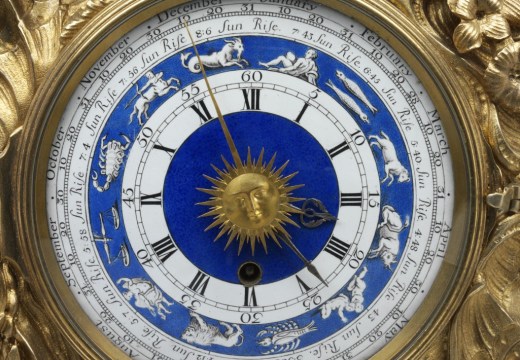One of the most important collections of 18th-century silver in Europe has been the focus of almost nine years intensive research by James Rothwell, advisor on silver to the National Trust. Eleven years ago he published Country House Silver from Dunham Massey with James Lomax, and his in-depth knowledge of that collection (assembled by George Booth, 2nd Earl of Warrington) has provided an ideal springboard for this scholarly account of the Ickworth silver.
Drawing on surviving documentary evidence, this handsome book explores the patronage of successive members of the Hervey family. Tracing family ownership of silver back to the 15th century, the introduction focuses on the leading patrons, John Hervey, 1st Earl of Bristol (1665–1751) and his grandson George William, 2nd Earl of Bristol (1721–75), who was the British ambassador to Turin and later Madrid. The catalogue includes silver acquired by other Herveys, including John, Lord Hervey and his wife Mary Lepel, Lady Hervey and the notorious Earl Bishop.
The first earl’s accounts provide evidence for silver purchased second-hand, and as gifts to celebrate life events; for his own two marriages and royal christening gifts to his daughters Ann and Louisa. Selected citations record purchases of jewellery and expensive items of dress embroidered with silver or gold thread. Thus silver vessels catalogued in detail are seen in the context of precious accessories such as the gold snuffbox bought of ‘Mr Howerd’ in 1689 who agreed to refund the £6 ‘& a crown’ on demand or the eight diamond buckles provided in 1696 as a stomacher for the first earl’s second wife Elizabeth.
Among the silver furnishings for successive London houses in the fashionable parish of St James’s, Westminster, were several pairs of fireplace andirons and sets of silver sconces, including one with silver borders, and looking-glass plates (like those preserved at Drumlanrig Castle) supplied by David Willaume, a first-generation Huguenot goldsmith; his son is referred to as ‘Guillaume’ in 1732 providing rare evidence for the English pronunciation of this French name. Pierre Le Cheaube, the newly identified supplier of the 1726/7 silver kettle and lamp, was a former apprentice of Willaume and, like his master, originally from Metz, France.
Evidence for the Herveys’ engagement with local Suffolk activities includes payments for racing trophies: a ‘Monteth’ (punch bowl) weighing 134 oz to be run for at Bury and subsequently given to the town’s corporation in April 1705; or £5 given in April 1712 to the ‘Poor at Newmarket, when my Horse call’d Ickworth won ye Queens Plate of 100 Guineys value there’. Gifts given and received are also recorded. In 1744/5 the first earl demonstrated his appreciation of his housekeeper Mrs Williams with the gift of ‘a Sett of Casters…upon her Accepting the office…it being much beneath Her Birth or other Excellent Qualitys’. In April 1726, the earl accepted ‘ye gold Cupp’ from Lady Howard of Effingham ‘as a Present from Her which she desir’d
I would accept to remember her by’.

Communion flagon (1705/6), John Jackson I and John Fawdery I. Ickworth House, Suffolk. Photo: © National Trust Images/Robert Thrift
George William, 2nd Earl of Bristol was the principal patron of the Ickworth silver, inheriting his grandfather’s plate as his father had died in 1743. He was educated at Delaplace’s French School in London, taught at Westminster School by a Huguenot tutor, studied at the Academy in Geneva, and thus conditioned for polite living and a diplomatic career.
On his first appointment as British ambassador to Turin, the second earl ensured that his domestic equipment would signify sufficient status to enable him to compete with other foreign ambassadors. The 72 dinner plates he inherited were insufficient for diplomatic entertaining so he ordered a further four dozen from the Turin goldsmiths Andrea Boucheron and P.A. Paroletto within a year of his arrival. The pair of tureens supplied in 1752 by Frederick Kandler, London, decorated with cast root vegetables, ingredients for soup, and surmounted by the family crest (a black snow leopard with gold spots) were matched by a pair of round tureens by Turinese goldsmiths. The four tureens provided the symmetry to the table setting dictated by contemporary manuals such as Vincent La Chapelle’s The Modern Cook, first published in London in 1733. Not all the earl’s silver was modern; he retained the 1680 wine cistern bought by his grandfather second-hand from Baptist May in 1697.
James Rothwell traces the survival of this family silver and demonstates its function by quoting contemporary recipes for drinking chocolate, or instructions for using a silver preserving basin for making desserts and melting butter. He celebrates the vision of Theodora, Marchioness of Bristol, who ensured that there was sufficient endowment for the National Trust to take on Ickworth and its contents in 1956. This beautifully illustrated and rigorously researched celebration of the Ickworth silver certainly achieves the author’s aim in showing how ‘the decorative arts played their part in the social, cultural and political history of this nation and of Europe’. The knowledge, commitment, and enthusiasm in this volume will broaden engagement with this appetising subject and the stories that silver can tell.
Silver for Entertaining: The Ickworth Collection by James Rothwell is published by Philip Wilson Publishers Ltd.
From the May 2017 issue of Apollo. Preview and subscribe here.














![Masterpiece [Re]discovery 2022. Photo: Ben Fisher Photography, courtesy of Masterpiece London](http://zephr.apollo-magazine.com/wp-content/uploads/2022/07/MPL2022_4263.jpg)
Suzanne Valadon’s shifting gaze